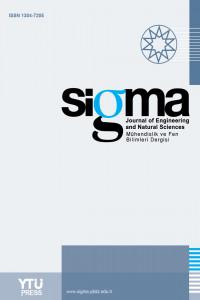DETERMINATION OF OPTIMUM CUTTING PARAMETERS ON FREE FORM SURFACES IN TERMS OF FORM ERRORS AND MACHINING TIMES
Abstract
In this study, the most suitable cutting conditions were determined from which obtained the lowest form error. Freeform surfaces were machined in CNC milling machine. In experiments, Al7075 series material was used because of its special features. Because Al7075 series material is frequently used in many areas with high strength and easy machinability. Firstly, four factor consisting of cutting speed, feed rate, step over, machining strategies were determined. Later, 4 levels were selected for the each factor according to manufacturer catalog of the cutting tool. After an experiment list was created. The Taguchi method was used while the creating of L16 ortogonal array. At the end of the experiments, form errors were found and signal noise (S/N) ratios determined with using the Taguchi method. The most suitable cutting conditions were determined as a result of the analyzes of expeiments. According to Taguchi method, the 2-3-1-1 orthogonal array outside the designed L16 was the optimum condition; So, the smallest form error value was obtained by 140 m/min cutting speed, 800 mm/min feed rate, 0.5 mm step over and parallel machining strategy. Also in this study, it was appeared that the cutting factors that affect form error, which are the step over, cutting speed, feed rate and machining strategies in order of importance. Moreover, in ANOVA results, step over showed significance at the 95% confidence level on form error. It is possible to comment on the best machining conditions according to the obtained machining times and form errors.
References
- ⦁ Bouzakis, K. D., Aichouh, P. and Efstathiou, K., (2003) “Determination of the chip geometry, cutting force and roughness in free form surfaces finishing milling, with ball end tools. International Journal of machine tools and manufacture, 43(5), 499-514
- ⦁ de Souza, A. F., Machado, A., Beckert, S. F. and Diniz, A. E., (2014) “Evaluating the roughness according to the tool path strategy when milling free form surfaces for mold application”, Procedia CIRP, 14, 188-193.
- ⦁ Özkan, M. T., Ulas, H. B. and Bilgin, M., (2014) “Experimental design and artificial neural network model for turning the 50CRV4 (sae 6150) alloy using coated carbide/cermet cutting tools”, Materiali in Tehnologije, 48(2), 227-236.
- ⦁ Wojciechowski, S., Maruda, R. W., Barrans, S., Nieslony, P. and Krolczyk, G. M., (2017) “Optimisation of machining parameters during ball end milling of hardened steel with various surface inclinations”, Measurement, 111, 18-28.
- ⦁ Ghani, J. A., Choudhury, I. A. and Hassan, H. H., (2004) “Application of Taguchi method in the optimization of end milling parameters”, Journal of materials processing technology, 145(1), 84-92.
- ⦁ Zhang, J. Z., Chen, J. C. and Kirby, E. D., (2007) “Surface roughness optimization in an end-milling operation using the Taguchi design method”, Journal of materials processing technology, 184(1), 233-239.
- ⦁ Bagci, E. and Yüncüoğlu, E. U., (2017) “The effects of milling strategies on forces, material removal rate, tool deflection, and surface errors for rough machining of complex surfaces”, Strojniški vestnik-Journal of Mechanical Engineering, 63(11), 643-656.
- ⦁ De Lacalle, L. L., Lamikiz, A., Sanchez, J. A., & Salgado, M. A. (2007). Toolpath selection based on the minimum deflection cutting forces in the programming of complex surfaces milling. International Journal of Machine Tools and Manufacture, 47(2), 388-400.
- ⦁ Wang, S. J., To, S., & Cheung, C. F. (2013). An investigation into material-induced surface roughness in ultra-precision milling. The International Journal of Advanced Manufacturing Technology, 68(1-4), 607-616. 9
- ⦁ Wojciechowski, S., & Mrozek, K. (2017). Mechanical and technological aspects of micro ball end milling with various tool inclinations. International Journal of Mechanical Sciences, 134, 424-435. 10
- ⦁ Karabulut, Ş. (2015). Optimization of surface roughness and cutting force during AA7039/Al2O3 metal matrix composites milling using neural networks and Taguchi method. Measurement, 66, 139-149.
- ⦁ Gok, A., Gologlu, C. and Demirci, H. I., (2013) “Cutting parameter and tool path style effects on cutting force and tool deflection in machining of convex and concave inclined surfaces”, The International Journal of Advanced Manufacturing Technology, 69(5-8), 1063-1078.
- ⦁ Yaka, H., Demir, H. and GÖK, A., (2017) “Optimization of the cutting parameters affecting the surface roughness on free form surfaces”, Sigma Journal of Engineering and Natural Sciences, 35(2), 323-331.
- ⦁ Bagci, E. and Yüncüoğlu, E. U., (2017) “The Effects of Milling Strategies on Forces, Material Removal Rate, Tool Deflection, and Surface Errors for Rough Machining of Complex Surfaces”. Strojniški vestnik-Journal of Mechanical Engineering, 63(11), 643-656.
- ⦁ Günay, M. and Yücel, E., (2013) “Application of Taguchi method for determining optimum surface roughness in turning of high-alloy white cast iron”, Measurement, 46(2), 913-919.
- ⦁ Kim, G. M., Kim, B. H. and Chu, C. N., (2003) “Estimation of cutter deflection and form error in ball-end milling processes”, International Journal of Machine Tools and Manufacture, 43(9), 917-924.
- ⦁ Ozdemir, B., Guler, M. S., Bahçe, E. and Aktaş, S., (2016) “Serbest şekilli yüzeylerin frezelenmesinde işleme parametrelerinin form hatası üzerine etkilerinin araştırılması”, Ordu Univ. J. Sci. Tech., 6(2), 300-315.
- ⦁ Erdim, H., Lazoğlu, I., Ozturk, B., (2006) “Feedrate scheduling strategies for free-form surfaces”, International journal of machine tools & manufacture, 46 (7) 747-757.
Details
| Primary Language | English |
|---|---|
| Journal Section | Research Articles |
| Authors | |
| Publication Date | December 1, 2018 |
| Submission Date | June 27, 2018 |
| Published in Issue | Year 2018 Volume: 36 Issue: 4 |
IMPORTANT NOTE: JOURNAL SUBMISSION LINK https://eds.yildiz.edu.tr/sigma/


